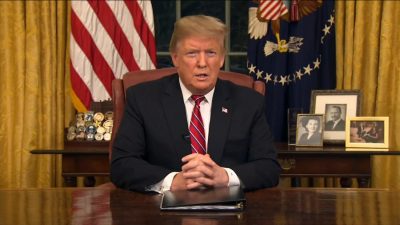Trump’s Steel Barrier Border Fortification, Partial Government Shutdown, “Where is the Emergency”?

New year occasions, given the pleasant fiction it entails, are times to change. Resolutions are made by that delightful species Homo sapiens, hope packaged for quick delivery to those who promise change. The weak will become stronger; the strong will show humility. The venal, well, they just might change.
Human nature suggests the opposite, and 2019 has begun with an unsurprisingly consistent thud from the White House. The House Democrats have barricaded themselves on one side; President Donald Trump mans the opposing positions. A partial government shutdown has been in effect for almost three weeks. But the new year tidings have merely made the president more insistent. He demands $5.7 billion to construct a steel barrier as part of the border fortifications along the US-Mexico border, and reminds Democrats that they did, in 2006, vote for a physical barrier of 1,120 km. Overall, he insists this is small beer, as Mexico will fund the wall through a rejigged North American Free Trade Agreement. Mexican officials and politicians beg to differ, as they always have.
In his January 8 address, the president insisted on a “growing humanitarian and security crisis at our southern border” (growth of a crisis is a common Trump theme). That particular “southern border is a pipeline for vast quantities of illegal drugs, including meth, heroin, cocaine and fentanyl. Every week 300 of our citizens are killed by heroin alone, 90 percent of which floods across from our southern border.”
Source: The New York Times
For Trump, selective culling and trimming is essential to any message that winds its way to the public sphere that can be dared called a forum. He edits texts, perceptions and accounts to oblivion, putting in place his distinct variation. Where there is something minor, there is bound to be a catastrophe. Where there is a calamity, it is bound to be distinctly minor.
This was his view on the use of emergency powers as described by Adam Smith, the sort he hopes to use in dealing with getting funds to resolve his Mexican problem, thereby ending the “humanitarian” and “security” crisis. Doing so would enable him to access sources otherwise frozen by the current shut down.
“Congressman Adam Smith, the new Chairman of the House Armed Services Committee, just stated, ‘Yes, there is a provision in law that says a president can declare an emergency. It’s been done a number of times.’”
That tweet is, as is the Trump method, right and wrong, and even he hopes to make sure that the work is best done through Congress. Smith did tell ABC News’s This Week that emergency powers were available to be invoked. But, as ever, the qualifying statement follows. “In this case, I think the president would be wide open to a court challenge saying, ‘Where is the emergency?’ You have to establish that in order to do this.’” Those words to George Stephanopoulos have managed to make their way into the ether of forgetting, as is the Trump way.
Political emergencies tend to be confections and propagations, puffed realities advanced by demagogues and figures of desperation. The issue of a Mexican emergency on the border has always been far-fetched, but last Friday, White House press secretary Sarah Sanders was insisting that there were 4,000 suspected or known terrorists who had been caught attempting to enter freedom’s land, with Mexico being the “most vulnerable point of entry”. Such a statement implied that Mexico was playing its own irresponsible part in ensuing this vulnerability to prosper. A qualifier was subsequently made by White House advisor Kellyanne Conway: the figures used in rather cavalier fashion by Sanders had been from 2017 for the whole set of attempted entrants.
Trump has some latitude in redirecting military funds by a declaration of a formal emergency under the National Emergencies Act of 1976. The threshold is surprisingly low, a more than generous nod towards executive flexibility in determining what might constitute a state of sufficient disturbance. What matters from Trump’s perspective is showing how the border wall would fit into the category of a military fortification. While his judgment might well be challenged in court, the issue of standing for any opponents will be problematic.
Trump has been attempting to make his own crusted resolutions, which seem very much like those made in 2018. For man quick to disturb and disrupt, he remains painfully, and sometime ineffectively, consistent. Even he found the issue of giving his January 8 address a bit of a bore, and did his boring best to remind us why he feels the Democrats should throw their lot in to assist the wall project.
Opponents should now know that the way through the man’s heart is to anticipate the proffering of a promise that can only be made by giving the impression that his wishes will be satisfied, only to then adjust the outcome. Pretend, and let the rest go. But politics in the Trump era remains, for the moment, ruled by a classic misapprehension: that the tweet is not only the message, but the whole message, to be attacked for its facts, presumed or otherwise. Treat it seriously at your own peril. As things stand after the January 8 speech, the words of Congressman Justin Amash of Michigan are as accurate as any: “Nobody convinced anybody.”
*
Note to readers: please click the share buttons above. Forward this article to your email lists. Crosspost on your blog site, internet forums. etc.
Dr. Binoy Kampmark was a Commonwealth Scholar at Selwyn College, Cambridge. He lectures at RMIT University, Melbourne. He is a frequent contributor to Global Research and Asia-Pacific Research. Email: [email protected]

